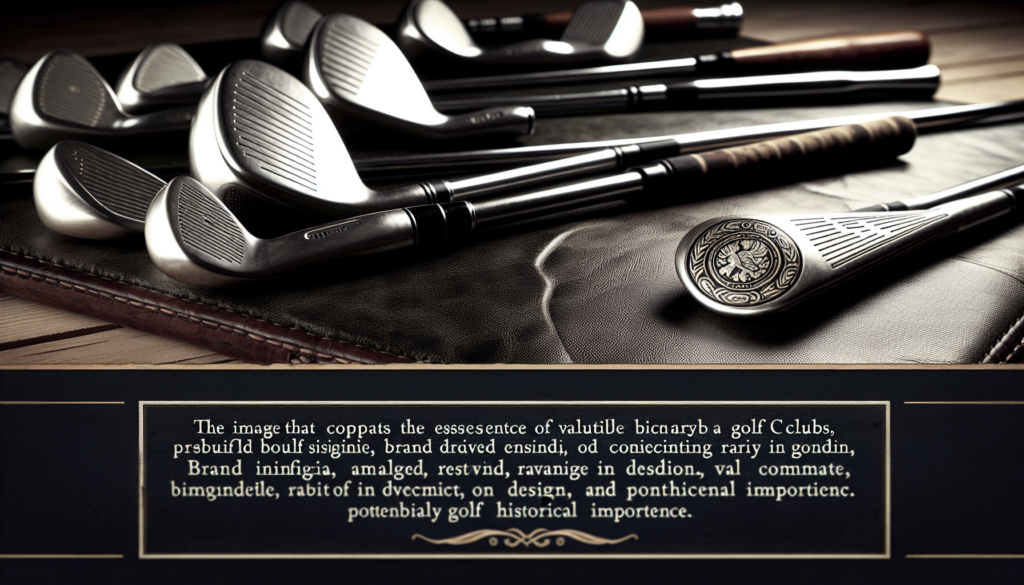
If you’re an avid golfer or just starting out, you may have wondered how to determine if your golf clubs hold any value. With so many different brands, models, and variations available, it can be challenging to identify which ones are truly valuable. Whether you’re hoping to make a profitable sale or simply curious about the worth of your collection, this article will provide you with essential tips and tricks on how to identify golf clubs that are worth money. By understanding the key factors that contribute to a club’s value, you’ll be able to assess their worth with confidence and make informed decisions regarding your golfing equipment. So, let’s dive into the world of valuable golf clubs and discover how you can spot them.

Factors to Consider
When it comes to determining the value of golf clubs, there are several factors that you need to consider. These factors play a crucial role in determining the overall worth of a golf club, and understanding them will help you make informed decisions when buying or selling clubs.
Brand
One of the most important factors to consider is the brand of the golf club. Certain brands are renowned for their quality and performance, which can significantly impact the value of the club. Brands like Titleist, Callaway, TaylorMade, and Ping are widely recognized and carry a sense of prestige in the golfing community. However, it’s worth noting that not all clubs from these brands are valuable, as other factors such as age and rarity also come into play.
Age and Rarity
The age and rarity of a golf club can greatly affect its value. Vintage clubs, especially those from iconic eras of the game, are often highly sought after by collectors and enthusiasts. Clubs that are no longer in production or have limited availability in the market tend to command higher prices. Additionally, clubs that have a historical significance or were used by famous players can fetch a premium price due to their rarity.
Condition
The condition of a golf club is another crucial factor that determines its value. Clubs in mint or excellent condition, with minimal signs of wear and tear, are generally more valuable than those in poor condition. Buyers and collectors are often willing to pay a premium for clubs that have been well-maintained and kept in top-notch condition. However, it’s important to note that the condition of the club should be evaluated holistically, taking into account factors such as clubhead, shaft, grip, and any repairs that might have been done.
Materials and Construction
The materials used in the construction of a golf club can have a significant impact on its value. Certain materials, such as titanium and graphite shafts, are known for their performance-enhancing properties and are highly desirable among golfers. Forged irons, which are crafted from a single piece of metal, are also prized for their superior feel and playability. On the other hand, vintage persimmon woods, made from hardwood, hold nostalgic value for many collectors. Understanding the materials and construction techniques used in a club can help you gauge its value.
Customization
Customized golf clubs are another factor to consider when assessing their value. Club stamping, signature engravings, and aesthetic modifications can add a unique touch to a club, making it more valuable to certain buyers. Collectors often seek clubs that have been personalized or customized by famous players or craftsmen. However, it’s important to note that not all customizations increase the value of a club. Some modifications may impact the club’s performance or alter its originality, which can affect its worth.
Researching Golf Club Brands
When it comes to researching golf club brands, there are various categories to consider. Recognized brands, popular brands, and vintage brands each have their own merits and appeal to different segments of golfers and collectors.
Recognized Brands
Recognized brands are those that have established a strong reputation in the golfing world. These brands are widely known for their craftsmanship, quality, and performance. Companies like Titleist, Callaway, TaylorMade, and Ping fall into this category. Clubs from recognized brands often hold their value well and are sought after by golfers looking for reliable and high-performing equipment.
Popular Brands
Popular brands, while not necessarily as widely recognized as the top-tier names, still have a significant presence in the golfing industry. These brands often offer a good balance of quality, performance, and affordability. Examples of popular brands include Cobra, Mizuno, Wilson, and Cleveland. Clubs from popular brands can provide excellent value for golfers who are looking for reliable clubs without breaking the bank.
Vintage Brands
Vintage golf clubs have a distinct appeal and are highly sought after by collectors and enthusiasts. Vintage brands such as MacGregor, Hagen, and Spalding have a rich history and are associated with iconic eras of the game. Owning a vintage club from one of these brands not only showcases a piece of golfing history but can also be a valuable investment. However, it’s important to do thorough research and seek expert advice when dealing with vintage clubs to ensure their authenticity and value.
Understanding Club Grading
When evaluating the condition of a golf club, it’s important to understand the different grading categories commonly used in the industry. These grading categories provide a standardized framework for assessing and communicating the condition of a club.
Mint Condition
A golf club in mint condition is considered to be in like-new condition or as close to new as possible. These clubs show no signs of wear, are free from any defects, and have been well-preserved. Clubs in mint condition often command the highest prices as they are highly sought after by collectors and golfers looking for pristine equipment.
Excellent Condition
Golf clubs in excellent condition have been lightly used and show minimal signs of wear and tear. They may have a few minor scratches or blemishes but are overall in top-notch shape. Clubs in excellent condition offer great value for buyers who are looking for clubs that are almost new but at a more affordable price point.
Good Condition
Clubs in good condition have been moderately used and show noticeable signs of wear and tear. These clubs may have several scratches, scuffs, or small dents, but they are still in playable condition. Clubs in good condition are often more budget-friendly and suitable for golfers who prioritize performance over aesthetics.
Fair Condition
Fair condition clubs have been heavily used and show significant signs of wear and tear. These clubs may have visible dents, dings, scratches, and worn-out grips. Despite their cosmetic flaws, fair condition clubs can still serve as functional equipment for golfers on a tight budget.
Poor Condition
Clubs in poor condition have been extensively used and are in a severely worn state. These clubs may have major cosmetic damage, such as cracked clubheads or bent shafts, rendering them unusable or in need of major repairs. Clubs in poor condition are typically not sought after by collectors or golfers and have minimal value.
Identifying Valuable Club Materials
The materials used in the construction of a golf club can significantly impact its value. Understanding the value and properties of different materials can help you identify clubs that are likely to be more valuable.
Titanium
Titanium is a lightweight and durable material commonly used in clubheads. Clubs with titanium clubheads are often highly valued due to their strength, forgiveness, and ability to generate distance. Titanium clubs are particularly popular among both professional and amateur golfers due to their performance-enhancing properties.
Forged Irons
Forged irons are crafted from a single piece of metal, resulting in a solid and precise clubhead. These clubs offer excellent feel, control, and shot-shaping capabilities. Forged iron clubs are often associated with premium quality and are highly sought after by golfers who value precision and craftsmanship. Due to their superior construction, clubs with forged iron heads tend to be more valuable.
Graphite Shafts
Graphite shafts are a popular choice among golfers due to their lightweight nature, which allows for increased swing speed. These shafts provide enhanced distance, improved accuracy, and reduced vibrations. Clubs with graphite shafts are often well-regarded and can command a higher value due to their performance benefits.
Vintage Persimmon Woods
Vintage persimmon woods hold a special place in the hearts of golf collectors and enthusiasts. These woods, made from hardwood, were commonly used before the advent of modern clubhead materials. Vintage persimmon woods are highly valued for their classic aesthetic appeal and nostalgic charm. Owning a persimmon wood club from a reputable brand can be a significant addition to a collection and may hold considerable value.

Recognizing Customized Clubs
Customized golf clubs can add a unique touch and increase the value of a club. Identifying the various types of customization can help you determine the potential value of a club.
Club Stamping
Club stamping refers to the process of adding personalized letters, numbers, or symbols to the clubhead. This can include a player’s initials, name, or specific designations such as “PGA Tour” or “Ladies” to indicate the intended user. Golf clubs with personalized stampings are often more valuable due to their unique and customizable nature.
Signature Engravings
Signature engravings involve the addition of autographs or personal signatures to the clubhead or other parts of the club. These engravings can be from famous professional golfers, renowned club designers, or even previous owners with historical significance. Clubs with signature engravings are highly sought after by collectors and enthusiasts looking to own a piece of golfing history.
Aesthetic Modifications
Aesthetic modifications encompass a wide range of changes made to the appearance of a golf club. This can include custom paint jobs, unique finishes, or personalized colors and patterns. While these modifications may not necessarily impact the performance of the club, they can add an element of personalization and uniqueness, making the club more appealing to certain buyers. The value of these modifications will vary depending on the taste and preferences of potential buyers.
Evaluating Golf Club Condition
When assessing the value of a golf club, thoroughly evaluating its condition is crucial. Paying attention to various aspects of the club can provide valuable insights into its overall worth.
Inspecting the Clubhead
Start by closely examining the clubhead for any signs of damage or wear. Look for dents, cracks, or chips in the clubface, as these can significantly affect the performance and value of the club. Additionally, check the sole of the clubhead for scratches or signs of excessive wear. A well-preserved clubhead with minimal damage will likely have a higher value.
Examining the Shaft
The condition of the shaft is another important aspect to consider. Look for any visible signs of damage, including bending, splitting, or rusting. Run your hand along the shaft to check for any irregularities or rough spots that may affect the grip. A shaft in good condition, with no major flaws, will generally increase the value of the club.
Checking the Grip
The grip of a golf club plays a crucial role in maintaining control and comfort during a swing. Inspect the grip for any signs of wear, such as cracks, excessive wear patterns, or peeling. A well-maintained grip will enhance the overall value of the club, as it may indicate that the club has been properly cared for.
Assessing Wear and Tear
Evaluate the overall wear and tear of the club, considering factors such as scratches, scuffs, and paint chips. Minor cosmetic imperfections are expected with regular use, but excessive damage can significantly impact the value of the club. Look for any signs of abuse or neglect, as these may indicate poor overall condition.
Noting Any Repairs
Keep an eye out for any repairs that have been done on the club. Minor repairs, such as re-gripping or re-shafting, may not significantly impact the value if done professionally. However, major repairs or modifications, such as replacing the clubhead or altering the original design, can significantly diminish the value of the club. Be cautious of extensive repairs that may compromise the club’s performance or authenticity.
Understanding Golf Club Types
To accurately assess the value of a golf club, it’s essential to familiarize yourself with the different types of clubs and their intended purposes.
Drivers
Drivers, also known as 1-woods, are designed to hit long-distance shots off the tee. These clubs have larger clubheads, which provide increased forgiveness and help generate maximum distance. Drivers are a staple in any golfer’s bag and are an integral part of the game.
Woods
Woods, ranging from 2-woods to 7-woods, are used primarily for long shots from the fairway or rough. These clubs are designed to provide distance and accuracy, with a lower loft than irons. Woods are known for their ability to launch the ball high into the air, making them a go-to choice for long shots.
Irons
Irons are the most versatile clubs in a golfer’s bag, offering a range of distances and shot types. They are numbered from 1 to 9, with higher numbers indicating greater loft and shorter distance. Irons are used for shots from the fairway, rough, or around the green, providing both distance and control.
Wedges
Wedges are specialized irons designed for shots that require a high degree of accuracy and control. These clubs have higher lofts than standard irons, allowing for precision shots with high trajectory and spin. Wedges are commonly used for shots around the green, in bunkers, or for approach shots requiring a higher arc.
Putters
Putters are used on the putting green to roll the ball into the hole. These clubs have a flat clubface and a unique design that prioritizes accuracy and control over distance. Putters come in various shapes and sizes to accommodate different putting styles and preferences.
Examining Performance Features
Aside from the brand and condition of a club, various performance features can impact its value. Understanding these features will help you assess the potential performance and desirability of a club.
Clubhead Design
The design and technology used in the clubhead can greatly impact a club’s performance. Features such as a low center of gravity, perimeter weighting, or adjustable weight systems can enhance forgiveness, increase distance, or improve shot trajectory. Clubs with innovative or highly regarded clubhead designs are often more valuable.
Face Technology
The face of a golf club is a critical component that directly affects ball speed, spin rate, and launch angle. Clubs with advanced face technology, such as variable thickness faces, grooves designed for enhanced spin control, or face inserts, can deliver improved performance and higher value.
Sweet Spot Size
The sweet spot refers to the specific area on the clubface that delivers maximum energy transfer to the ball. Clubs with larger sweet spots are considered more forgiving and are valued by golfers seeking consistency and improved performance. The size and location of the sweet spot can influence a club’s value.
Weight Distribution
The distribution of weight within a golf club can greatly impact its playability and performance. Clubs with optimized weight distribution, such as perimeter weighting or a low center of gravity, can enhance stability, forgiveness, and distance. Golfers often seek clubs with well-balanced weight distribution, which can contribute to their overall value.
Shaft Flexibility
The flexibility of a golf club’s shaft affects the feel and performance of the club. Shafts with different flex ratings, such as regular, stiff, or extra stiff, offer varying degrees of flexibility. Golfers’ swing speeds and preferences play a crucial role in determining the ideal shaft flexibility. Clubs with shafts that cater to a wide range of players tend to be more desirable and valuable.
Recognizing Collectible Golf Clubs
Collectible golf clubs hold a special allure for enthusiasts and collectors looking to own a piece of golfing history or a unique work of art. Several categories of collectible clubs have gained recognition and value in the golfing community.
Hickory Shaft Clubs
Hickory shaft clubs harken back to the early days of golf and hold a significant historical value. These clubs feature shafts made from hickory wood, which provides a distinct feel and aesthetic. Owning a set of hickory shaft clubs, whether for display or play, can be a cherished addition to any collection.
Persimmon Head Clubs
Persimmon head clubs were prevalent during the wooden club era and are highly valued for their classic beauty and craftsmanship. These clubs feature clubheads made from persimmon wood, which provided a unique feel and sound upon impact. Collectors often seek clubs with well-preserved persimmon heads, particularly those made by iconic brands.
Handcrafted Clubs
Handcrafted clubs are meticulously crafted by skilled artisans, often using traditional techniques and materials. These clubs demonstrate a level of craftsmanship and attention to detail that sets them apart from mass-produced clubs. Handcrafted clubs are highly sought after by collectors who appreciate the artistry and precision that goes into their creation.
Replicas
Replica clubs are recreations of historically significant clubs or limited-edition releases. These clubs aim to capture the essence and design of classic or iconic clubs while incorporating modern manufacturing techniques. Replicas can provide golfers and collectors alike with the opportunity to own a piece of golfing history or experience nostalgic equipment.
Consulting Experts and Appraisers
When in doubt or seeking more accurate valuations, it’s advisable to consult industry experts and appraisers who specialize in golf clubs. Their knowledge and experience can provide valuable insights into the value, authenticity, and desirability of clubs.
Local Golf Professionals
Local golf professionals, such as club fitters or instructors, are well-versed in equipment and can offer guidance on club values. They may also have connections or resources to help you connect with potential buyers or sellers. Golf professionals can provide expert opinions on the condition and performance of clubs, ensuring that you make informed decisions.
Golf Club Collectors
Golf club collectors have a wealth of knowledge and expertise when it comes to valuing and assessing clubs. Engaging with collectors and joining relevant communities or forums can help you learn more about specific clubs, brands, and their market value. Collectors often have extensive networks and can provide valuable insights into the collectible market.
Auction Houses
Auction houses specializing in sports memorabilia or golf collectibles can be excellent resources for valuing and selling golf clubs. These establishments have experts who evaluate clubs and assist in the auctioning process. Auction houses provide a platform for connecting buyers and sellers, ensuring fair market prices and maximizing the potential value of your clubs.
Online Valuation Services
Various online platforms offer valuation services for golf clubs. These services typically require detailed information, including club brand, model, condition, and any unique features or modifications. Online valuation services can provide estimates of a club’s value based on current market trends and historical data. While not as personal as consulting an expert or appraiser in person, online valuation services can be a convenient starting point for assessing a club’s worth.
In conclusion, determining the value of golf clubs involves considering various factors such as brand, age, condition, materials, and customizations. Thorough research, evaluation of condition, and understanding of club types and performance features are essential in accurately assessing a club’s worth. Consulting experts and appraisers, whether local professionals, collectors, auction houses, or online valuation services, can provide valuable insights into the value and marketability of your clubs. By considering these factors and seeking expert guidance, you can make informed decisions when buying, selling, or valuing golf clubs, ensuring that you maximize their potential worth.





